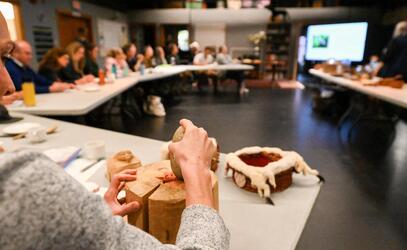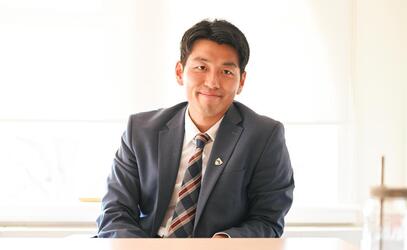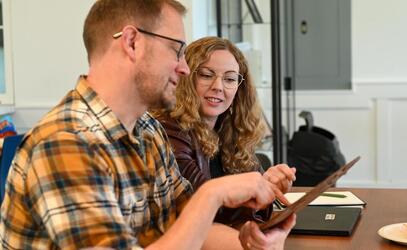Every year, we are honoured to recognize members of the SMUS community as they retire and take on new adventures. Read the 2019 Retirees series to learn more about their outstanding contributions to the school. In this story, we recognize Mary Smith, former Middle School music teacher.
Mary Smith
Mary Smith taught strings at SMUS for 33 years.
Credited for building a thriving string ensemble program and for inspiring many young musicians, Mary considers that it may have been her teaching style that contributed to success. It allowed for committed development. Additionally, it was the power of the music-making that supported the activity. “If there were students sitting around this table now” she says, “they would be nodding in agreement about one, or both, of these aspects.”
She also credits Leonard Takoski, who was building the school’s orchestral program when she started at SMUS in 1986. He was a mentor whose secret to success in its inaugural years (1980s) was that all students in Grades 4 and 5 took part in string instrument study. That approach remains and many students benefit from playing during their Junior School years, gaining experience through several rich musical opportunities.
At SMUS, strings students had a myriad of opportunities to perform in different configurations. From small ensembles to solos in chapel, as accompanists to choral presentations, as pit orchestra musicians for musicals at the McPherson Playhouse, they participate often in making music. The Junior School curriculum provides excellent foundational learning in rhythm, melody and harmony which primes learners effectively in their early years. At the Middle School students choose to study band or strings and sing in a choir. Mary cherished the “growing sense of commitment as they developed skills in musical expression through taking part in choral singing and strings simultaneously.”
The process of delivering the strings curriculum remained consistent from year to year as Mary taught at the Junior and Middle School campuses. She used traditional learning methods that are time-tested and allow for logical, sequential progress. What did shift was the repertoire and what suggestions students brought. Also, Mary learned how to use Finale, a music notation software while on a leave of absence in Kuala Lumpur where her husband was working as an orchestra manager. This was a game changer as she could then compose études and studies for ensemble use at SMUS.
For six years, Mary was the faculty representative on the SMUS Society Board of Governors. It was a “fabulous opportunity.” She enjoyed contributing and participating with a group that was active and task oriented, she says. “They steadily connect with the community and contribute whole-heartedly at the governance level.”
Mary’s two sons graduated from SMUS. Gregory ’01 is the Technical Director at the Belfry Theatre and Christopher ‘98 has now taken on the leadership of the Middle School strings program alongside his primary music teaching duties at the Junior School.
Reflecting on her time at the school, Mary notes that over the years chapel services have changed a great deal. She tips her hat to the chaplain for speaking to the “grand diversity” of spiritual needs, contemplations and practices of students across the campus. She believes that chapel services provide essential gathering times. Other shifts she references are the integration of technology, the establishment and healthy development of the Learning Resource Centres and the dramatic growth in composition of the student body.
Retirement provides a much different pace than teaching strings. Previously Mary was “always delivering” through moving and setting furniture, conducting, encouraging, composing, listening, focusing, enjoying, thinking and steadily planning. Now she participates in cycling, reading, embroidery projects and plays with the Victoria Chamber Orchestra, also designing its concert programs. Mary has been a member of this orchestra for 18 years and is currently its principal cellist. She is also preparing herself for volunteering as a performing musician for patients at the Royal Jubilee Hospital. “There is much to learn,” she says.
As this year progresses, Mary looks forward to hearing the concerts of the students she nurtured. For the most part, however, she’s intent on not overscheduling herself. “I’m taking time to settle,” she beams.
Last thoughts? She pauses. “It matters not how one comes to being involved in the world of music, there is always something to be gained and appreciated.”


